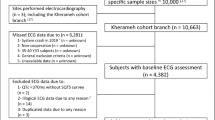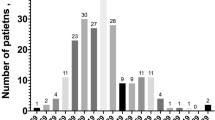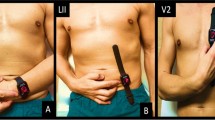Abstract
Background
Whether preterm birth is associated with cardiac conduction or repolarization abnormalities in later life is still poorly explored, with conflicting data on QTc prolongation in former extreme low birth weight (ELBW, <1000 g) infants.
Methods
Twelve lead electrocardiograms (ECG) at rest, collected in the PREMATurity as predictor of children’s Cardiovascular-renal Health (PREMATCH) study in former ELBW cases and term controls during pre-adolescence (8–14 years) were analyzed on corrected QT time (QTc, Bazett) and QT dispersion (QTd). ECG findings were compared between groups (Mann−Whitney), and associations with clinical and biochemical findings were explored (Spearman). In ELBW cases, associations between QTc and perinatal characteristics (at birth, neonatal stay) were explored (Mann−Whitney, Spearman).
Results
QTc and QTd were similar between 93 ELBW cases and 87 controls [409 (range 360–465) versus 409 (337–460); 40 (0–100) versus 39 (0–110)] ms. Age, height, weight, or body mass index were not associated with the QTc interval, while female sex (median difference 11.4 ms) and lower potassium (r = −0.26) were associated with longer QTc interval. We could not observe any significant association between QTc interval and perinatal characteristics.
Conclusions
There were no differences in QTc or QTd between ELBW and term controls in ECGs at rest in pre-adolescents.
Impact
-
This study aimed to assess the differences in QTc and QTd intervals between extreme low birth weight infants (ELBW) and term controls in electrocardiographic measurements at rest during pre-adolescence.
-
This analysis confirmed the absence of significant differences in QTc or QTd findings between ELBW cases and term controls, while female sex and lower potassium were associated with a prolonged QTc interval.
-
These data suggest that QTc screening strategies—including for pharmacovigilance—should not differentiate between former ELBW cases and term controls.
Clinical trial registration
ClinicalTrials.gov Identifier NCT02147457
Similar content being viewed by others
Log in or create a free account to read this content
Gain free access to this article, as well as selected content from this journal and more on nature.com
or
Data availability
The corresponding author can be contacted to share the raw data, if based on a reasonable request and a study protocol.
References
Leeson, P. & Lewandowski, A. J. A new risk factor for early heart failure: preterm birth. J. Am. Coll. Cardiol. 69, 2643–2645 (2017).
Carr, H., Cnattingius, S., Granath, F., Ludvigsson, J. F. & Edstedt Bonamy, A. K. Preterm birth and risk of heart failure up to early adulthood. J. Am. Coll. Cardiol. 69, 2634–2642 (2017).
Risnes, K. et al. Mortality among young adults born preterm and early term in 4 Nordic nations. JAMA Netw. Open 4, e2032779 (2021).
Luyckx, V. A. et al. A developmental approach to the prevention of hypertension and kidney disease: a report from the Low Birth Weight and Nephron Number Working Group. Lancet 390, 424–428 (2017).
Bourque, S. L. & Davidge, S. T. Developmental programming of cardiovascular function: a translational perspective. Clin. Sci. 134, 3023–3046 (2020).
Telles, F. et al. Changes in the preterm heart from birth to young adulthood: a meta-analysis. Pediatrics 146, e20200146 (2020).
Gervais, A. S. et al. Electrocardiographic features at rest and during exercise in young adults born preterm below 30 weeks of gestation. Pediatr. Res. 88, 305–311 (2020).
Bassareo, P. P. et al. Significant QT interval prolongation and long QT in young adult ex-preterm newborns with extremely low birth weight. J. Matern. Fetal Neonatal Med. 24, 1115–1118 (2011).
Bassareo, P. P., Fanos, V. & Mercuro, G. Young adults born preterm below 30 weeks of gestation and risk of QT tract prolongation. Pediatr. Res. 88, 143 (2020).
Flahault, A. & Nuyt, A. M. Author’s response regarding manuscript entitled “Electrocardiographic features at rest and during exercise in young adults born preterm below 30 weeks of gestation” and subsequent correspondence. Pediatr. Res. 88, 151–152 (2020).
Akyuz, A. et al. Does low birth weight affect P-wave and QT dispersion in childhood? Pacing Clin. Electrophysiol. 36, 1481–1487 (2013).
Raaijmakers, A. et al. Design and feasibility of “PREMATurity as predictor of children’s cardiovascular-renal Health” (PREMATCH): a pilot study. Blood Press. 24, 275–283 (2015).
George, I., Mekahli, D., Rayyan, M., Levtchenko, E. & Allegaert, K. Postnatal trends in creatinemia and its covariates in extremely low birth weight (ELBW) neonates. Pediatr. Nephrol. 26, 1843–1849 (2011).
Raaijmakers, A. et al. Does extremely low birth weight predispose to low-renin hypertension? Hypertension 69, 443–449 (2017).
Center of Education and Research in Therapeutics of the University of Arizona (AzCERT). Risk categories for drugs that prolong QT & induce torsades de pointes (TdP) https://www.crediblemeds.org/index.php/druglist (2014).
Malik, M. & Batchvarov, V. N. Measurement, interpretation and clinical potential of QT dispersion. J. Am. Coll. Cardiol. 36, 1749–1766 (2000).
Bazoukis, G. et al. Association of QT dispersion with mortality and arrhythmic events—a meta-analysis of observational studies. J. Arrhythm. 36, 105–115 (2019).
Kosmopoulos, M. et al. Increased QT dispersion is linked to worse outcomes in patients hospitalized for out-of-hospital cardiac arrest. J. Am. Heart Assoc. 9, e016485 (2020).
Faul, F., Erdfelder, E., Buchner, A. & Lang, A.-G. Statistical power analyses using G*Power 3.1: tests for correlation and regression analyses. Behav. Res. Methods 41, 1149–1160 (2009).
United States Food and Drug Administration. FDA Center for Drug Evaluation of Research (CDER). General clinical pharmacology considerations for pediatric studies for drugs and biological products. Guidance for industry. https://www.fda.gov/regulatory-information/search-fda-guidance-documents/general-clinical-pharmacology-considerations-pediatric-studies-drugs-and-biological-products (2014).
Lester, R. M., Paglialunga, S. & Johnson, I. A. QT assessment in early drug development: the long and the short of it. Int. J. Mol. Sci. 20, 1324 (2019).
Franz, A. P. et al. Attention-deficit/hyperactivity disorder and very preterm/very low birth weight: a meta-analysis. Pediatrics 141, e20171645 (2018).
Tommiska, V. et al. Analysis of neurodevelopmental outcomes in preadolescents born with extremely low weight revealed impairments in multiple developmental domains despite absence of cognitive impairment. Health Sci. Rep. 3, e180 (2020).
Chai, G. et al. Trends of outpatient prescription drug utilization in US children, 2002−2010. Pediatrics 130, 23–31 (2012).
Raaijmakers, A. et al. Catch-up growth in the first two years of life in extremely low birth weight (ELBW) infants is associated with lower body fat in young adolescence. PLoS ONE 12, e0173349 (2017).
Jayanthi, R., Girijasivam, S. P. & Gaur, A. Association of blood pressure and BMI to corrected QT interval in young adults. Can. J. Physiol. Pharmacol. 99, 894–899 (2021).
Celik, T., Iyisoy, A., Kursaklioglu, H. & Turhan, H. QT dispersion: electrophysiological holy grail or the greatest fallacy in the surface ECG? Int. J. Cardiol. 117, 404–405 (2007).
Acknowledgements
We gratefully acknowledge the contribution of the nurses working at the examination center (Linda Custers, Marie-Jeanne Jehoul, Daisy Thijs, and Hanne Truyens) and the clerical staff at the Studies Coordinating Centre at time of data acquisition (Vera De Leebeeck and Renilde Wolfs).
Funding
This study was supported by the “Agency for Innovation by Science and Technology in Flanders (IWT)” through the “SAFE-PEDRUG” project (IWT/SBO 130033).
Author information
Authors and Affiliations
Contributions
A.R., J.A.-S. and K.A. conceived and designed the PREMATCH study and obtained the funding. The electrocardiographic findings were assessed on quality by T.S., while T.S., A.R. and K.A. designed and performed the analysis. All authors were involved in the interpretation and drafting of the manuscript, approved the final manuscript as submitted and agree to be accountable for all aspects of the work.
Corresponding author
Ethics declarations
Competing interests
The authors declare no competing interests.
Informed consent
Parents or custodians and children provided written informed consent and assent respectively.
Additional information
Publisher’s note Springer Nature remains neutral with regard to jurisdictional claims in published maps and institutional affiliations.
Rights and permissions
About this article
Cite this article
Salaets, T., Raaijmakers, A., Zhang, ZY. et al. QTc intervals are not prolonged in former ELBW infants at pre-adolescent age. Pediatr Res 92, 848–852 (2022). https://doi.org/10.1038/s41390-021-01877-w
Received:
Revised:
Accepted:
Published:
Issue date:
DOI: https://doi.org/10.1038/s41390-021-01877-w



